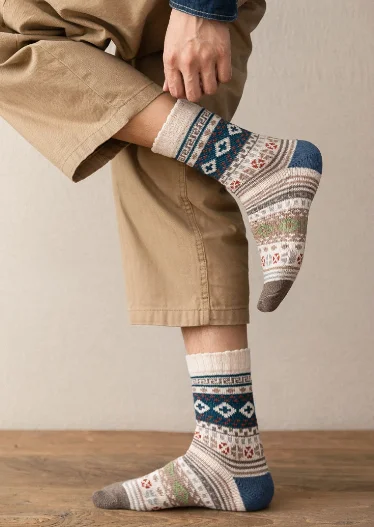Different materials, wearing comfort: the comparison of wool and cotton socks
Wearing comfortable socks can make our feetfeel warm and soft, and it can also increase our confidence and happiness. Whenwe wear socks of different materials, we will feel different degrees ofcomfort. In this article, we'll explore the differences between wool and cottonsocks and compare their pros and cons for comfort.

Wool socks are made from wool, this type ofsocks has great warmth and is ideal for winter. They're perfect for outdooractivities and will keep your feet from getting cold. Another benefit of woolsocks is that they are soft, non-irritating to the skin, and non-allergenic. Atthe same time, wool is also hygroscopic, which can keep feet dry and preventberiberi and other infections.
Cotton socks, on the other hand, are madeof cotton. Cotton socks have good air permeability, which can keep the feet dryand comfortable. They're also hygroscopic to absorb sweat and prevent footodor. Cotton socks are also a great option, Especially in summer or hotweather, to soothe uncomfortable feet.
While both wool and cotton socks have theirown advantages, they also have some disadvantages. For example, wool socks cansometimes cause overheating or humidity, especially in warmer indoortemperatures. This can lead to sweaty and odorous feet. socks are not as warmas wool socks, especially when the temperature is low, and cotton socks canfeel cold.
But in the cold winter, it is moreappropriate to choose wool socks than cotton socks. Here are a few reasons:
First of all, wool socks keep warm better.Wool is a natural fiber that is very warm. According to research, compared withcotton, wool has higher thermal insulation performance, because wool itself hasgood thermal insulation performance, which can prevent the body from losingheat too quickly. Cotton is a fiber with strong hygroscopicity. In a humidenvironment, cotton socks will absorb a large amount of water, resulting inreduced warmth retention. In contrast, wool socks are better at keeping feetwarm and dry.
Secondly, wool socks have good airpermeability. Although wool is an insulating material, it is extremelybreathable. There are many pores on the surface of wool fiber, which can play arole in regulating temperature. When your feet sweat, wool socks absorb anddisperse it quickly, keeping your feet dry. Although cotton socks have stronghygroscopicity, their air permeability is relatively poor, which can easilymake the feet feel damp and affect the warmth retention effect.
In addition, wool socks also have greatdurability. Because wool is a natural fiber and is soft, wool socks last longerthan regular socks. Moreover, the wool fiber is not easy to deform and wear,and can maintain its original shape and texture, so the service life of woolsocks is very long.
Precautions for the use of wool socks
Avoid wearing for a long time: Wool sockshave good thermal performance, but wearing them for a long time may causeproblems such as athlete's foot and itchy skin. It is recommended not to wearthem for more than 8 hours.
Avoid high-temperature washing: Wool socksare not suitable for washing with high-temperature water and strong detergents,so as not to damage the fiber structure and shrink and deform.
Avoid sun exposure: the color of wool socksis easily faded by sunlight exposure, so it is recommended to avoid directexposure to the sun when drying.
Avoid friction: When wearing wool socks,avoid friction with sharp objects to avoid scratching the socks.
In short, in the cold winter, it is moreappropriate to choose wool socks than cotton socks. Wool socks have betterthermal performance, breathability and durability, which can better protect thefeet and make people spend more comfortable time in the cold winter.


评论
发表评论